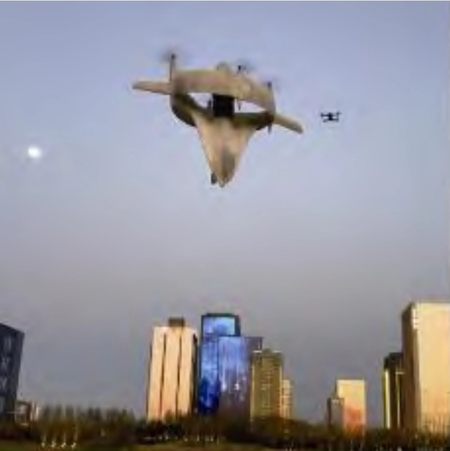At the end of 2017 the New York Times launched one of that news that is remembered for what it could mean. A secret program of the Pentagon was revealed that was dedicated to investigating the threats raised by possible UFOs. And among all the information, the star news: the encounter of an unidentified object with two combat fighters (with video included). The origin of those strangers in the sky has never been confirmed.
Until China has announced something.
The echo of the “gimbal”. As we said, that video of the object called “Gimbal”, captured by a F/A-18 of the US Navy, unleashed a global debate on inexplicable aerial phenomena and technologies beyond known military capacities.
Today, almost a decade later, China, through the Zhengzhou University of Aeronautics, has presented a tracing of what we saw in those images, an experimental drone of take -off and vertical landing (Vtol) whose design, surprisingly, reminds that of that mysterious artifact: a fuselage with elliptical wing in the form of a closed ring, reinforced by vertical stabilizers and four vertical stabilizers Rotors located at union points.

One of the Chinese Experimental Drones in Test Flight in Zhengzhou, Henan Province
The Chinese revolution in Vtol. At first glance it looks like a flying spindle more than a conventional plane or quadcopter. However, in that unorthodox form an engineering is hidden that combines the best of multi -reliable and fixed -wing systems: maneuvering capacity and vertical support to operate from ships, irregular terrain or even aquatic surfaces, and at the same time aerodynamic efficiency in horizontal flight, thanks to a wing whose slope of support curve exceeds more than 100% to that of a line.
Radical aerodynamics. Beijing researchers have that the annular wing channels high pressure flows and delays the loss, which allows stable to fly at low speeds or high attack angles, key conditions for military recognition missions in complex environments.
The horizontal stabilizer mounted at the ends avoids internal turbulence and improves control. Plus: Tunnel tests and test flights confirmed that the device maintains the attached flow even in extreme conditions, validating computational models that predicted a leap into benefits.

A close look at DRON VTOL Chino
Purposes. Its robust modular structure allows, on paper, to integrate optical sensors, thermal cameras, rescue equipment or supply capsules, which makes it a multipurpose platform for both military missions (battlefield supervision, maritime surveillance) and for civil applications (environmental analysis, rescue in difficult access areas, light emergency transportation).
Limitations and margin of improvement. The great challenge remains the aerodynamic drag, inherent in the geometry of the closed wing. In that sense, researchers have stressed that they work to refine the profile to reduce pressure resistance and optimize the support/resistance ratio.
Plus: They seek to perfect control algorithms to minimize unnecessary corrections that generate induced drag, and also study “more stylized variants designed to operate from war ships”, which would multiply its strategic value in naval operations.
Of speculation to the battlefield. Thus, what for much of the world was an unknown unknown a decade ago, China has now translated it into a tangible system, the result of the convergence of academic research and, of course, military pressure to reach the next generation of drones.
If in the cold war the boldest experiments were on paper, today engineering (and China goes in the top positions) manages to validate designs that were just a few years ago as pure fantasy. The similarity with the “gimbal” is casual or intentional, but the truth is that the drone inaugurates a different aerodynamic language, one in which the borders between science fiction and military development are blurred.
Image | Handout, Pentagon, Zhengzhou University of Aeronautics
In WorldOfSoftware | The Pentagon confirms the truth and shows for the first time three “secret” videos of alleged UFOs that had leaked
In WorldOfSoftware | The Pentagon has just published the study on the material found in 1947 from an alleged “extraterrestrial” ship
